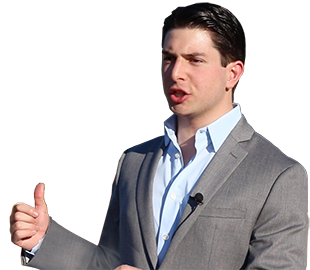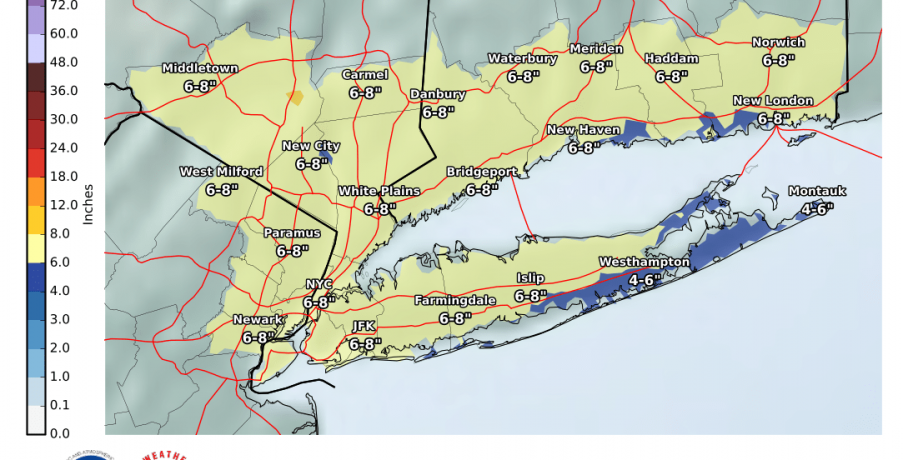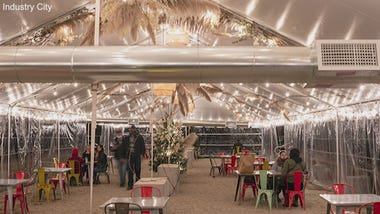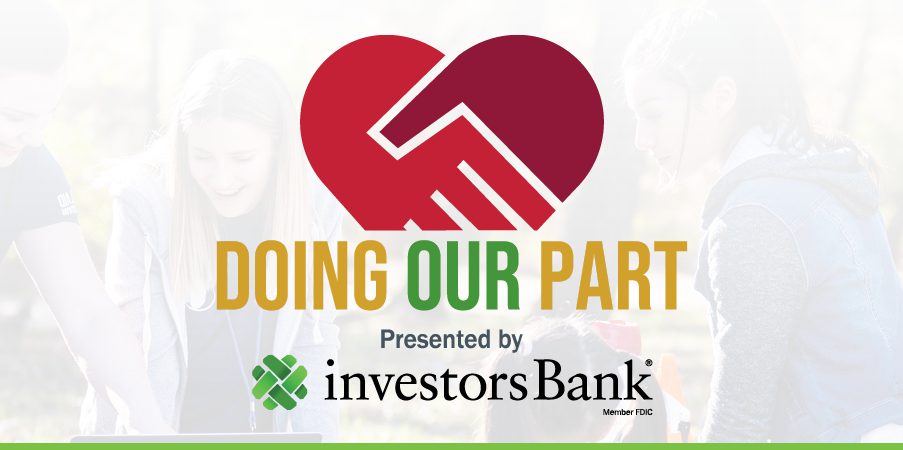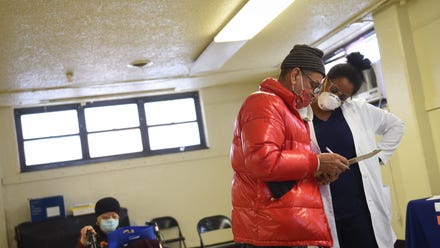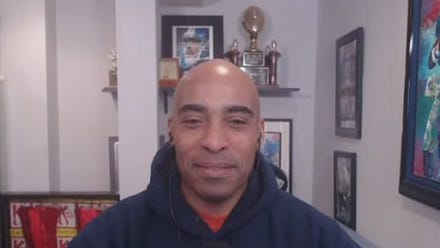
Neil A. Carousso produces NewsNation original “Kurt’s Country” – a celebration of country music and a slice of Americana with host Kurt Bardella.
-
Warnings, Advisories in Effect as Another Winter Storm Takes Aim at Tri-State Area
Post Views: 702By WCBS Newsradio 880
NEW YORK (WCBS 880) — Keep those shovels handy!
Another round of winter weather is expected to bring even more snow and mixed precipitation to the Tri-State area.
A winter storm warning has been issued for parts of New Jersey while a winter weather advisory has been issued for New York City, Long Island and other parts of the Tri-State area.
Snow, rain, sleet and ice are making for treacherous road conditions. Our Chief Meteorologist Craig Allen is tracking the storm and let's us know what's in store for tonight. https://t.co/8ifExpdqO0 pic.twitter.com/0PSzu4imsX
— WCBS 880 (@wcbs880) February 18, 2021Snow arrived Thursday morning and continued throughout the day, falling heavily at times. It’s expected to change over to sleet, freezing rain or plain old rain along the coast and in the city Thursday night.
“It will accumulate rapidly because it’s very cold out there,” WCBS 880’s Chief Meteorologist Craig Allen said. “The ground will be frozen.”
Keep those shovels handy! @CraigAllenWx says we're in store for even more snow across New York City and the surrounding areas. He's got the latest on the timing and potential snow totals: https://t.co/b1DvbLOudi pic.twitter.com/2c1ni077Qz
— WCBS 880 (@wcbs880) February 17, 2021During the afternoon hours, some of the major roadways, especially if treated, may see slushy or just wet conditions, but most other areas will have slippery or hazardous travel.
Some lingering snow will continue Friday morning before it tapers down to flurries and moves out.
By the time the storm is all said and done, most of the region will see between 4 and 8 inches of snow, with possibly up to a foot well north and west of city.
“I am sure there’s going to be a few areas that come in with 10, 11, 12 inches of snow, especially interior spots where there is absolutely no changeover,” Allen said. “It’s another prolonged event. It starts Thursday morning, it goes right on through into Thursday night and the first part of the Friday commute.”
Strong winds and coastal flooding are not anticipated with the storm.
Utilities, including Con Edison and PSEG, warn the storm may cause tree limbs to break and pull down wires, causing outages.
Utilities have extra crews on the ready to deal with any weather-related issues caused by the snowstorm.
Ahead of the storm, Nassau County rescheduled COVID-19 vaccination appointments.
“We’re going to reschedule at our Nassau County points of distribution, that’s Yes We Can Community Center, the community college and LIU, we’re going to be rescheduling the Thursday and Friday second dose appointments for Monday,” Nassau County Executive Lauran Curran said.
Curran said the county will work with people who can’t reschedule for Monday.
Sites are expected to be up and running Saturday and Sunday.
Nassau Inter-County Express/NICE Bus advises riders to plan for likely delays and detours on Thursday and Friday.
The MTA said articulated buses will be removed from the road starting Wednesday night ahead of the storm and remaining local buses will be fitted with chains. A 35-mph speed restriction on all MTA Bridges will be implemented once the storm begins.
“The service that’s most likely to be affected is buses,” MTA Chairman Pat Foye told WCBS 880. “We don’t expect there will be a significant impact on subway or commuter rail service.”
MTA employees are in force spreading salt and clearing surfaces of snow and ice, keeping signals, switches, and third rails operating. Crews will also remove any downed trees that may fall across tracks and attend to any weather-related challenges during the storm.
The agency is urging customers to stay home and avoid unnecessary travel during the storm.
“While we are encouraging riders to avoid non-essential travel, the system will be running for the essential workers who need it and we do not expect to have to curtail above-ground service given the current forecast,” said Demetrius Crichlow, Acting Executive Vice President of the New York City Transit Department of Subways. “Crews from New York City Transit will be out before, during and after the storm to make sure staircases and platforms are clear, but customers are still encouraged to check for service changes before they travel.”
In New York City, Open Streets and Roadway Dining are suspended Thursday. Sidewalk dining remains open.
Alternate Side Parking Regulations are suspended through Saturday.
Mayor Bill de Blasio said vaccine sites, testing sites and food distribution sites will remain open during the storm. Some testing sites were however closing early.
The New York City Emergency Management Department has also issued a hazardous travel advisory for Thursday and Friday.
“Thursday’s snow may come in fast throughout the afternoon. We are ready to fight it, as we have throughout this busy winter, but we need all New Yorkers to help by staying off the roads and giving us the space and time to do our work,” said Edward Grayson, Commissioner of the New York City Department of Sanitation.
New Jersey State Police responded to 92 crashes and assisted 55 drivers during the early hours of the winter storm.
Gov. Phil Murphy is urging New Jerseyans to stay off the roads.
He also said the snow here and winter storms across the country are further hampering the vaccine distribution.
“This may result in many appointments needing to be rescheduled,” he cautioned.
Due to the storm, vaccine mega sites are closed in New Jersey, except for the hub located at Rowan University in South Jersey.
Warming centers have been opened statewide in New Jersey.
Suffolk County Police responded to dozens of crashes during the storm, many on Sunrise Highway.
County Executive Steve Bellone is warning the storm will last through Friday afternoon on Long Island.
“Right from the outset of this obviously we’re seeing difficult conditions on the roadway, slick conditions, our big concern of course will be the evening commute,” Bellone said.
Westchester County Executive George Latimer has similar concerns.
“It’s gonna take time to try to keep roads clear and we are concerned about the rush hour today. From the county standpoint we’re having our county workforce leave earlier to try to give them a little bit of advanced notice and we encourage people to stay off the roads if they’re not on the roads,” Latimer said. “By the same token if they do have to leave, try to leave befor the heart of rush hour.”
He said the mass vaccination clinic at the Westchester County Center is open until 7 p.m. Thursday.
Hundreds of flights have been canceled at John F. Kennedy, Newark and LaGuardia airports. Travelers are urged to check with their airlines on their flight status.
Saturday will be partly sunny and brisk with highs in the mid-30s.
Sunday is mostly sunny and cold. The high will be 34.
Neil A. Carousso produces and edits WCBS Chief Meteorologist Craig Allen’s forecast videos.
-
Small Business Spotlight: Industry City Draws Scores of Weekend Shoppers, Positions Retail ‘Partners’ to Succeed
Post Views: 666By Joe Connolly and Neil A. Carousso
NEW YORK (WCBS 880) — Industry City has developed the holy grail of retailing by attracting 10,000 visitors each weekend – 75 percent of pre-pandemic volume – while investing in its tenants’ recovery.
The historic complex bills itself as “Brooklyn’s vibrant creative hub along the scenic waterfront of Sunset Park,” housing 550 local shops, restaurants and manufacturers – many of which have suffered steep losses. But, Industry City’s largely open-air space has allowed them to operate safely. About 40 percent of its tenants have reopened since the shutdown.
“They can safely come, hang out, have a drink, see some music, shop at Sahadi’s, shop at Japan Village, etc. and that’s really helped them considering the environment,” Industry City Director of Development Jim Somoza said on the WCBS Small Business Spotlight, sponsored by Dime Community Bank.
The complex owns its own streets and has sprawling outdoor dining space with large tents for inclement weather.
Somoza was part of the development team of Chelsea Market, starting in 2003, before embarking on Industry City’s vision of new-age retail-tainment featuring innovative local businesses that appeal to Brooklynites and tourists alike.
He told Joe Connolly and Neil A. Carousso about several Industry City tenants, including a blacksmith that entices customers to the waterfront space.
“While they’re coming to see that, they’re also buying a drink at the Frying Pan, they are going to Standard Wormwood and Brooklyn Kura,” Somoza said, adding, “They bring people to the overall project.”
Industry City’s business plan revolves around the experience, which he describes as the “antidote to the Internet.” People are itching for an outlet and Somoza anticipates high post-pandemic demand.
“When we are doing our jobs well at I.C., we’re transporting people,” he said. “We’re taking you away.”
Shoppers can take blacksmith classes at Nazz Forge, savor chocolate as they watch it being made at Li-Lac Chocolates, and watch the Christophe Pourny Studio restore antique furniture on the other side of the glass. This connects consumers and producers on another level through an Epcot-like or Hershey Park adventure in Sunset Park, Brooklyn.
It could be the model for business communities who will need to convince hardened online shoppers to shop local and in-person.
Businesses in Industry City have been set up to recover and succeed. Somoza told WCBS 880 he likes to think of their role as a “partner” to its tenants rather than a “landlord” – a word he avoids using.
“What we do is we support them,” he explained.
At the outset of the coronavirus pandemic, Industry City offered rent breaks, changed leases to percentage rent, and helped business owners navigate the Paycheck Protection Program (PPP) loan applications and requirements.
“I think that’s a part of the reason, with one exception, every single one of our retailers has reopened,” said Somoza.
Small and mid-size businesses there feel they are nearing the finish line at the end of an arduous year, according to Somoza, who noted many are applying for the latest round of the PPP loan.
See keys for creating economic development to recover from the pandemic on the WCBS Small Business Spotlight video above.
-
‘Doing Our Part:’ Inspiring Organizations With Inspiring Stories
Post Views: 1,017Executive Produced and Edited by Neil A. Carousso
Investors Bank is proud to present “Doing Our Part,” an important series of interviews created to spotlight New York and New Jersey organizations working for the well-being of the communities they serve.
Whether providing food for those in need, helping struggling businesses or offering programs for local youth, these organizations play a critical role. The Investors Foundation recognizes their impact and supports them in their efforts. Watch and listen to the interviews below to learn how these inspiring organizations are doing their part.
https://player.vimeo.com/video/492300187
https://player.vimeo.com/video/493775975
https://player.vimeo.com/video/495869386
https://player.vimeo.com/video/498019515
https://player.vimeo.com/video/500198342https://player.vimeo.com/video/498479546https://player.vimeo.com/video/498478890https://player.vimeo.com/video/498479319https://player.vimeo.com/video/498479213For the past 15 years, the Investors Foundation has helped support local civic-minded organizations and initiatives with contributions of more than $40 million. Learn about the Investors Foundation and its activities, including how it may be able to help your organization.
-
State of Black New York: The Racial Divide in Health Care and Education
Post Views: 740By Lynda Lopez, Marla Diamond and Steve Burns, WCBS Newsradio 880
NEW YORK (WCBS 880) — Over the next three weeks, WCBS Newsradio 880 is going to be spending time digging into a comprehensive report released by the New York Urban League titled, “The State of Black New York.”
We at WCBS 880 and Entercom New York are pleased to partner with the New York Urban League to shine the spotlight on issues of inequity in our community in important areas like health care, education, the digital divide, social justice, the economy, and civic engagement.
https://omny.fm/shows/880-weekly-rewind/special-report-the-state-of-black-new-yorkArva Rice, President and CEO of the New York Urban League, said the organization utilized data from Robin Hood & Columbia University’s Poverty and Early Childhood Poverty Trackers and also worked with United Way and the New York Women’s Foundation to provide statistical information on how African Americans are faring in comparison to their White counterparts.
“It’s really important for us to release the ‘State of Black New York’ report this year,” Rice said. “Our national office releases the ‘State of Black America’ on an annual basis and we had not released the ‘State of Black New York’ in over 10 years. In conjunction with our centennial, we wanted to be able to have a clearer baseline of how African Americans were doing in several key areas.”
The report not only lays out issue and statistics, it also includes actionable steps to facilitate change.
“It is important for us to shine the light on inequality, but to also provide some concrete strategies and policy suggestions on how to close those disparities and close those gaps,” Rice said.
As we tackle the report, this week reporters Marla Diamond and Steve Burns focus on health and education.
THE RACIAL DIVIDE IN HEALTH CARE
According to the New York Urban League report, one in four Black adults in New York City faced a health problem in 2018.
Today, they are twice as likely to die from COVID-19 than White people — making up 28% of deaths from the virus despite being only 22% of the city’s population.
Elisabeth Benjamin, Vice President of Health Initiatives at the Community Service Society, said this is the result of the state’s 30-year pro-market agenda.
“This is what structural racism looks like in the health care field. So in the 90s, we eliminated any semblance of regional health planning and centralized it up in Albany with a committee controlled by private and voluntary hospitals,” Benjamin said. “Although charities in name often do not act in very charitable ways toward their patients.”
Reimbursement rates were deregulated, allowing the most powerful hospital systems to get stronger, pushing out smaller community hospitals serving poor Black neighborhoods. The health care burden was pushed onto the city’s hospital system, which strained under the weight of the pandemic.
“So that’s why you see the New York Times and many, many articles about what was going on in Elmhurst, which was sort of the last hospital standing in Queens, versus what was going on in sort of well-heeled Manhattan hospitals,” Benjamin said.
The COVID crisis has revealed layers of inequities that The Rev. Calvin Butts sees firsthand at the Abyssinian Baptist Church in Harlem.
“The virus becomes a problem because cancer is still a problem; the virus becomes a problem because heart disease is still a problem; the virus becomes a problem because diabetes is still a problem. So this really digs deep into an underlying reality that we have not been getting adequate health care in our communities,” Butts said. “And we could go even deeper — the lack of doctors, the lack of nurses, the lack of information.”
The church was the first house of worship in the state to offer the COVID-19 vaccine.
“And we have found that by having the site for vaccinations in the community, in the church, we had more people coming to receive the vaccine who feel more comfortable, who are dealing, they believe, with trusted voices from the community — their pastor, their church, their officers at the church — and this has been extremely successful. We vaccinated now over 1,000 people,” Butt said.
Vaccines are providing some peace of mind. It’s been hard to come by in a community dealing with the twin pandemics of the virus and racial injustice, said Dr. Jamila Codrington, past president of the New York Association of Black Psychologists.
“I’ve had to make more referrals to other clinicians, outpatient mental health facilities, substance abuse clinics, shelters. It’s not just mental health, but domestic violence rates are increasing, alcoholism and drug use is increasing, and these are all comorbidities with mental health,” she said.
A 2017 New York Department of Health report found African Americans are more likely to experience serious mental health problems, but less likely to receive follow up visits after hospitalizations.
Dr. Codrington said that is changing with culturally responsive messaging.
“We have therapy for Black girls, therapy for Black men, and they are making a difference,” she said.
Yet, finding a Black therapist can be difficult, especially for low income New Yorkers.
The American Psychological Association found Black psychologists make up just 4% of all psychologists nationwide.
The New York Urban League’s report was conceived before the COVID-19 pandemic and, as a result, had to be updated because some of the racial disparities were only compounded in the last year.
“The report was designed and ready to go out for distribution and COVID hit our communities and we had this inkling that COVID might impact us more than other places,” Rice said. “As you look at the issues having to do with underlying health issues that face the African American community, we found that COVID started to reach our communities at a higher level.”
So can it be fixed quickly?
“Quickly probably not, but it can be addressed,” Rice said. “There are specific strategies that we need to put in place in order to close that divide that include education, that include access to quality health care, that include dispelling some of the myths, and being able to have access to and encourage healthy eating.”
THE RACIAL DIVIDE IN EDUCATION
Another area where the gap is wide is in education.
According to the New York Urban League report, Black students are two times more likely to fall below proficiency levels in English than their White peers, and three times more likely in math.
As a result, graduation rates and completion rates in high schools for Blacks are much lower than Whites.
The report cites many possibly reasons.
Our Steve Burns takes a look at a few of them.
Jamaal Bowman, U.S. representative for New York’s 16th congressional district, said before he became a middle school principal, he often found himself on the other side of the principal’s desk.
“I was a hot mess in school,” said Bowman. “I used to get in a lot of trouble, I was acting out. I was in the dean’s office a lot. I was handcuffed as a student in middle school.”
In high school, he said he was suspended multiple times — punishments for actions that Bowman now realizes were a product of his environment.
“My father wasn’t around, constantly lying to me telling me he was coming to see me and not showing up. I was angry and frustrated about that, but I didn’t know how to communicate any of that, so that manifested with me acting out at school,” Bowman said.
The congressman says it’s that holistic approach, the understanding that kids come to school with some baggage that should transform our idea of discipline.
“Too often it’s a child acts up, the child is discarded,” Bowman said.
While suspensions have fallen dramatically during Mayor Bill de Blasio’s time in office they are still disproportionately being issued to students of color and students with disabilities, often leading to worse academic performance, more dropouts, and more of the behavior that was being discouraged in the first place.
“White children are looked at as being rambunctious or mischievous, Black and Latino children tend to be looked at as criminal and harmful and dangerous,” Bowman said. “Our kids they’re coming to school with so much on their plates.”
Moving to a restorative approach on discipline would be a big step forward.
“We need to have more policies around ensuring our schools have more social workers and counselors and child psychologists,” Bowman said.
For him, the transformation came when he was able to move to New Jersey to a new environment and center himself through football.
“And ultimately I became an All State football player and ended up playing football in college, so I was lucky. There are millions of kids who don’t get that opportunity,” Bowman said.
From elementary school tests scores, to SAT scores, to graduation rates, the racial disparities in New York City schools are clear.
“So many patterns become entrenched very early on in terms of the life trajectory of our students,” said Paula White, the executive director of Educators for Excellence.
She said universal pre-K for the city was a big step forward, but the momentum shouldn’t be lost.
“Just making sure that the school system is good enough that when they enter that it won’t flatten the gains,” White said.
One way to do that is through AP, or advanced placement courses, but White said there are hurdles for students of color.
“In some districts there is a recommendation process and what that actually does is it serves as a gatekeeper to who can actually take the classes,” White said.
Teacher biases can come into play, as can language barriers.
Despite more Black students enrolling in AP courses in recent years, the New York Urban League says the percentage who pass their AP tests has gone down.White said enrollment on its own is a step in the right direction.
“Exposure to rigor bodes well for later success and persistence in college,” White said. But removing those hurdles to enrollment would help even more. “If there’s just sort of universal access, if you elect to take the course then that just gets rid of one area.”
COVID has had a damaging impact on all communities when it comes to education, but especially those of color, where resources were already thin. So the question now is how do we recover from these losses?
Rice believes recovery will take years.
“When schools closed and moved to digital learning there were some young people who never turned on their computers,” Rice said. “They did not turn on their computers in some cases because individuals did not have them; they did not turn on their computers because there was not the one on one relationship in order to keep that engagement going with individual students; there were families that had four and five children and only access to one laptop. As a result, we are going to be having students who have lost months and months of education, months and months of support, in addition to things like proms and graduation parties and helping support filling out their college applications. The impact of that is going to be felt for years so we’re going to need to develop and create additional supportive services for young people.”
Rice is hopeful for the future and encourages people to do even more work in school buildings and to volunteer at churches, mosques and synagogues to become mentors and reading coaches.
“I have to implore people to be take this as their opportunity to be the change that they have been wanting to see in the world, but if we don’t do anything, if we don’t act in a different way, if we don’t respond to this unbelievable moment in time, then yes, we will lose a generation,” Rice said.
In the weeks ahead, we will be tackling the other issues in the report in greater detail such as civic engagement, the digital divide, the economy and social justice.
https://omny.fm/shows/880-weekly-rewind/new-thinking-on-reopening-schools-and-sports-venueNeil A. Carousso produces The 880 Weekly Rewind with Lynda Lopez Friday nights at 7 PM on WCBS Newsradio 880. Listen to this week’s full show on the media player above.
-
Small Business Spotlight: Retired Giant Tiki Barber Extends His run with Key Business Pivots
Post Views: 746By Joe Connolly and Neil A. Carousso
NEW YORK (WCBS 880) — Retired running back Tiki Barker is elusive and quick on the gridiron and in the boardroom.
Barber played ten seasons in the NFL with the New York Football Giants. Since retiring, he has followed his passion for business in which he earned his degree from the University of Virginia.
“What I learned, obviously from my football career but also my early business career, is that relationships are invaluable,” he told Joe Connolly and Neil A. Carousso on the WCBS Small Business Spotlight.
When the market crashed in 2008, the three-time Pro Bowler had to get out of an affordable housing partnership he entered with billionaire real estate developer Stephen Ross after he retired from the league in 2006. But, the relationship he formed and maintained with The Related Companies chairman and Miami Dolphins owner led to an opportunity years down the road when Ross invested in Thuzio – the events company Barber co-founded in 2012.
“How you manage those relationships are of paramount importance for things down stream,” Barber explained.
He finds it liberating to find new ways of doing business. That realization came when Thuzio was forced to make a halftime adjustment amid the coronavirus pandemic.
It moved online and hosted private virtual business talks with celebrity speakers, including “Shark Tank” star and FUBU founder Daymond John, retired New York Jets linebacker Bart Scott and executive chef Josh Capon. Barber and his partners later changed the business model to make all virtual events free because their presenting sponsors were willing to pay a premium for more viewers.
“More importantly, you want qualified eyes,” he said, adding, “You want to know who your audience is.”
The “Tiki & Tierney” co-host told WCBS 880 they create events for their sponsors to target specific business executives and groups who are likely potential clients. For example, sports betting operator DraftKings sponsored a Thuzio virtual talk with Barber and retired New York Mets captain David Wright.
“We have this aggregation of business executives who you specifically want to talk to and we’re bringing them together over a shared passion for sports or food or wine or business information,” Barber said of Thuzio’s appeal to sponsors.
The company hosts about 35 virtual events a month, which he said would be near impossible for them to pull off in-person. Thuzio grew from eight employees to 15 in the pandemic amid rising demand for content.
Barber’s business mindset has been shaped by his mentors and experiences in the NFL. The Giants great told Connolly and Carousso he was inspired by Jon Gruden’s motivational tactics. Gruden was the head coach for the Tampa Bay Buccaneers where his twin brother Ronde Barber played cornerback and won a Super Bowl in 2002.
“We all have things that disrupt our lives,” Tiki said, noting the hardships suffered in the pandemic. “Sometimes, you have to get up and fight for yourself and fight forward for your country and as an individual. And, that’s essentially what (Gruden) was saying.”
Barber tries to portray positivity and enthusiasm among his employees, because, as Barber recalled Gruden’s message, “It’s not just for you, it’s for people who are around you.”
Football is a team sport and the ex-Giant used it as an analogy in business throughout the Small Business Spotlight conversation. Giving the play-by-play of his Giants team record 95-yard touchdown run against the Oakland Raiders on December 31, 2005, he emphasized the blocking by his teammates that catapulted him into the end zone that Saturday night.
“Understanding that it takes everyone even those who don’t show up on the big screen in order to be successful” is the mantra that guides Barber’s post-football career.
Watch Joe Connolly and Neil A. Carousso’s conversation with Tiki Barber on the Small Business Spotlight video above.

